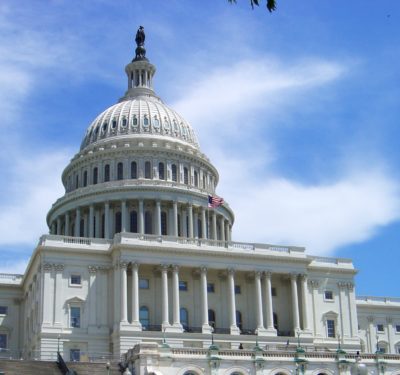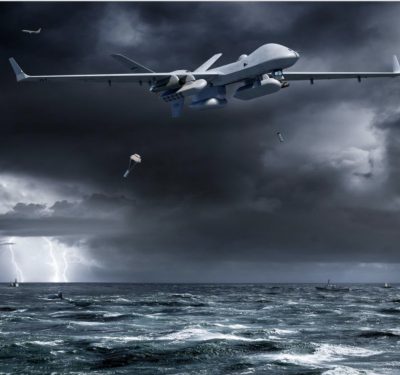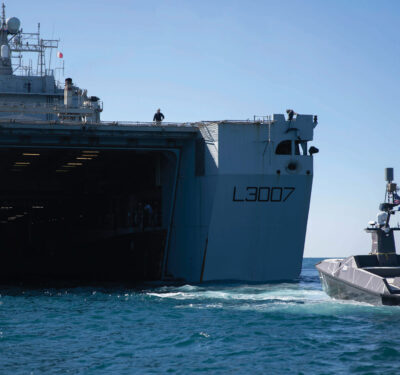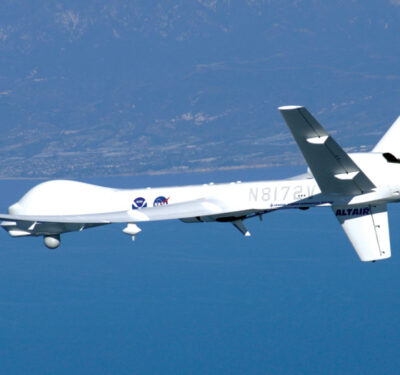
The Flirtey UAS transported the package of medical supplies to the fairgrounds, where it was lowered via tether. Jim Stroup, Virginia Tech
During the Let’s Fly Wisely event earlier this month, Flirtey UAS delivered pharmaceuticals and medical supplies to people who need them—something an unmanned aircraft system has never accomplished before in the United States.
Flirtey completed three test flights during the annual Remote Area Medical Clinic, or RMA, at the fairgrounds in Wise, Va., lowering the supplies via tether to volunteers waiting on the ground. The supplies went to clinic attendees, consisting of folks who live in the Appalachian Mountains who don’t have access to the supplies and medicine they need.
The NASA SR-22 remotely piloted aircraft delivered the supplies from the Tazewell County Airport to Lonesome Pine Airport. The Flirtey UAS then delivered the packages to people waiting at the RAM clinic. The Mid-Atlantic Aviation Partnership at Virginia Tech, or MAAP, oversaw these research flights, while the SEESPAN newsgathering tethered UAS system was on hand to capture the flights on video.
Jon Greene, MAAP associate director, said the test flights were a success, and the event was “perfect from every aspect.” They even had beautiful weather, with the morning fog lifting just in time for the test flights.
The team easily integrated the research flights into the airport’s operations—something they were initially concerned about—but the biggest challenge was the fact they couldn’t fly the drones over nonparticipants, Greene said. They had to block off the road to conduct the flights.
“It’s clear this was a very exciting first step, but only a first step,” he said. “We need to get to the point where we have confidence in the technology and the FAA has confidence in the technology so we can fly over populated areas and beyond line of sight. There’s a lot of work left to do.”
SEESPAN CEO Mark Ryan was excited to be part of this historic event, which he said incorporated three important UAS research categories—NASA with the long distance piece, Flirtey with the mid distance beyond visual line of sight piece, and SEESPAN with the line of sight portion of the demonstration and research.
During the event, SEESPAN conducted the closest approved drone flight and the first approved drone interview in the U.S. with Virginia Governor Terry McAuliffe.
SEESPAN is a startup media company that designed its tether system, used at the event, specifically for hyper-local newsgathering, Ryan said. They wanted to develop a technology that offered users full control of their UAS, and that has the ability to safely fly closer to people than the current 500 foot buffer the FAA allows. SEESPAN has put in a request for FAA authorization to fly 10 times closer than that—giving news organizations the proximity they need to capture video and photos of their subject matter.
The system provides power, strength and reliability, Ryan said. The high-speed tether line connects the UAS to a powerful electric retrieval base, which enables users to safely retrieve it if they somehow lose control during flight, increasing safety.
SEESPAN captured the event on video while many clinic attendees saw the test flights live. Greene said there were more people on hand for the event than he anticipated, and that overall the reaction to the test flights was positive.
While there aren’t any other flights scheduled just yet, Greene said the team is discussing what comes next. They want to continue research in this area to further evolve these types of humanitarian UAS missions, because they know they can really make a difference in remote areas, both in the U.S. and around the world.
“We view this series of flights as a pre-cursor to developing a capability to respond to humanitarian crisis,” Greene said. “There are a lot of situations in the mountains of southwest Virginia and other places around the world where people don’t have access to the things they need. RMA and the Health Wagon, who put on this health fair, see this technology as a real opportunity to save lives. We think we’re getting closer to the point where we can do that in the very near future.”






